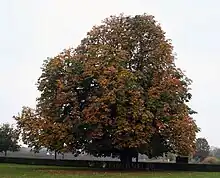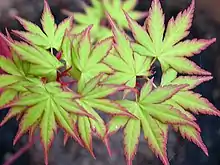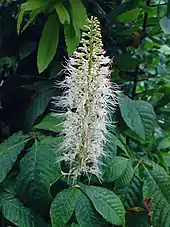| Hippocastanoideae | |
|---|---|
 | |
| Scientific classification | |
| Kingdom: | Plantae |
| Clade: | Tracheophytes |
| Clade: | Angiosperms |
| Clade: | Eudicots |
| Clade: | Rosids |
| Order: | Sapindales |
| Family: | Sapindaceae |
| Subfamily: | Hippocastanoideae Dumortier |
| Genera | |
Hippocastanoideae is a subfamily of flowering plants in the soapberry family Sapindaceae.[1] The group was formerly treated as the separate families Aceraceae and Hippocastanaceae. Molecular phylogenetic research by Harrington et al. (2005)[2] has shown that while both the Aceraceae and Hippocastanaceae are monophyletic in themselves, their removal from the Sapindaceae sensu lato would leave Sapindaceae sensu stricto as a paraphyletic group, particularly with reference to the genus Xanthoceras.
The most widespread genera are Acer (the maples) and Aesculus (the horse chestnuts and buckeyes). A feature of the subfamily is the palmate compound leaves.[3]
Genera
| Genus | Authority | Common Name | Number of Living Species | Image |
|---|---|---|---|---|
|
160 |
| |||
|
Linnaeus |
Horse-chestnuts & buckeyes |
13-19 |
| |
|
2 |
.jpg.webp) Billia colombiana | |||
|
2 |
| |||
|
1 |
||||
References
- ↑ "Genera of Sapindaceae subfam. Hippocastanoideae". Germplasm Resources Information Network. United States Department of Agriculture. Archived from the original on 2015-09-24. Retrieved 2009-04-11.
- ↑ Harrington, M. G., Edwards, K. J., Johnson, S. A., Chase, M. W., & Gadek, P. A. (2005). Phylogenetic inference in Sapindaceae sensu lato using plastid matK and rbcL DNA sequences. Systematic Botany 30: 366-382. Abstract.
- ↑ Hippocastanaceae Archived 2006-03-18 at the Wayback Machine in L.Watson and M.J.Dallwitz. 1992 onwards. The families of flowering plants.
![]() Media related to Hippocastanoideae at Wikimedia Commons
Media related to Hippocastanoideae at Wikimedia Commons


